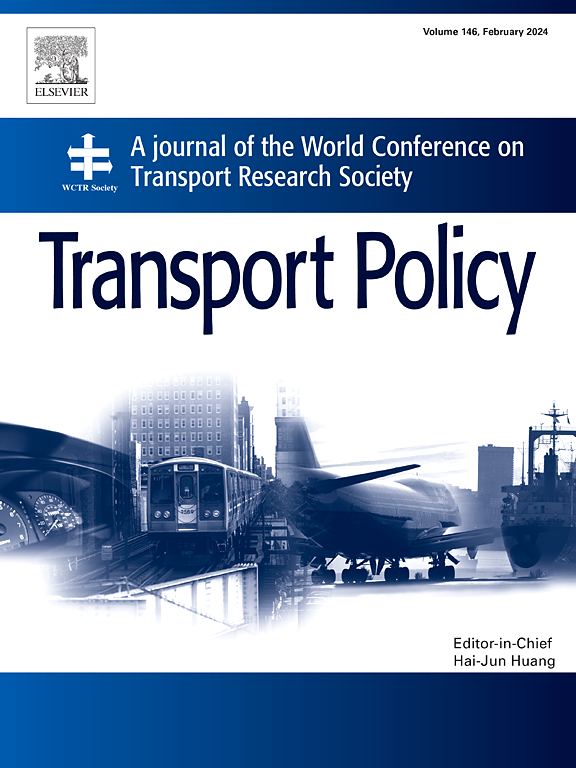Comparative analysis of carbon emission reduction policies in China's manufacturing and transportation sectors
IF 6.3
2区 工程技术
Q1 ECONOMICS
引用次数: 0
Abstract
This study evaluates China's environmental policies, specifically the increase of carbon emission tax rates and the reduction of carbon emission intensity, by developing a New Keynesian Dynamic Stochastic General Equilibrium (NK-DSGE) model that incorporates energy consumption and carbon emissions. The production sector is segmented into manufacturing, non-manufacturing, and transportation, with transportation services acting as inputs for both manufacturing and non-manufacturing firms. We construct four cases within two scenarios, each characterized by distinct targets and policies. After calibrating and estimating the relevant parameters, we compare carbon reduction outcomes and economic fluctuations across the two scenarios. Our findings indicate that when targeting the same carbon emission tax rate increase or carbon emission intensity ratio reduction, policies that increase the carbon emission tax rate or reduce carbon emission intensity implemented in the manufacturing sector achieve greater carbon emission reductions compared to the same polices implemented in the transportation sector. Meanwhile, compared to the latter case, output experienced a greater decline, and inflation exhibited a more substantial increase in the former case. However, when the quantities of carbon emission reductions are approximately the same in the first quarter, policies that increase the carbon emission tax rate or reduce carbon emission intensity enacted in the transportation sector demonstrate superior performance relative to the same polices implemented in the manufacturing sector. This leads to smaller final output reductions and milder inflation increases. In summary, for equivalent levels of carbon emission reductions, policies implemented in the transportation sector yield more favorable economic outcomes than those applied in the manufacturing sector.
中国制造业和交通运输业碳减排政策比较分析
本研究通过建立一个包含能源消耗和碳排放的新凯恩斯动态随机一般均衡(NK-DSGE)模型,对中国的环境政策进行评估,特别是碳排放税率的提高和碳排放强度的降低。生产部门分为制造业、非制造业和运输业,运输服务是制造业和非制造业企业的投入。我们在两个方案中构建了四个案例,每个案例都有不同的目标和政策。在校准和估算相关参数后,我们比较了两种情景下的碳减排结果和经济波动。我们的研究结果表明,在提高碳排放税率或降低碳排放强度比的目标相同的情况下,在制造业部门实施提高碳排放税率或降低碳排放强度的政策与在交通运输部门实施相同的政策相比,前者能实现更大的碳减排量。同时,与后一种情况相比,前一种情况下的产出下降幅度更大,通胀率上升幅度更大。然而,当第一季度的碳减排量大致相同时,在交通运输部门实施的提高碳排放税率或降低碳排放强度的政策相对于在制造业部门实施的相同政策表现出更优越的绩效。这导致了较小的最终产出减少和较温和的通胀上升。总之,在同等碳减排水平下,交通部门实施的政策比制造业实施的政策产生更有利的经济结果。
本文章由计算机程序翻译,如有差异,请以英文原文为准。
求助全文
约1分钟内获得全文
求助全文
来源期刊

Transport Policy
Multiple-
CiteScore
12.10
自引率
10.30%
发文量
282
期刊介绍:
Transport Policy is an international journal aimed at bridging the gap between theory and practice in transport. Its subject areas reflect the concerns of policymakers in government, industry, voluntary organisations and the public at large, providing independent, original and rigorous analysis to understand how policy decisions have been taken, monitor their effects, and suggest how they may be improved. The journal treats the transport sector comprehensively, and in the context of other sectors including energy, housing, industry and planning. All modes are covered: land, sea and air; road and rail; public and private; motorised and non-motorised; passenger and freight.
 求助内容:
求助内容: 应助结果提醒方式:
应助结果提醒方式:


